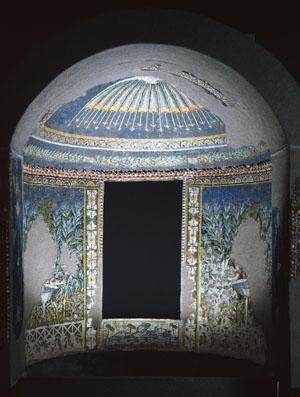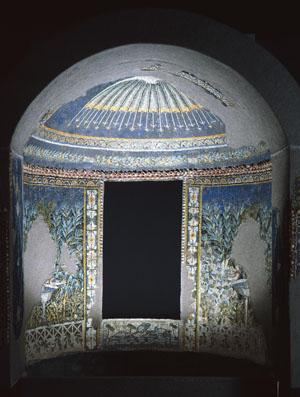PARIS—On Aug. 24, A.D. 79, a volcanic eruption left a sudden snapshot of the lives of the estimated 20,000 inhabitants of Pompeii, near Naples, Italy. This catastrophe, which is believed to have killed several thousand people, made it possible to preserve the ancients’ way of life in every detail to be revealed to us centuries later.
“Despite its terrible character the event was destined to be a source of great joy for posterity,” Stefano de Caro, professor at the University of Naples and member of the exhibition’s board, wrote in a statement to the exhibit.
Since its discovery in the middle of the 18th century, the city of Pompeii has inspired architects, writers, poets, and artists. The town, buried in the lava of the volcano Vesuvius, gives evidence of daily life in the Roman Empire like no other documentation.
Currently the Maillol Museum in Paris invites visitors to discover this ancient civilization’s lifestyle by wandering through the different rooms of a re-created house (called domus) of the legendary city. Dating mostly from a time period starting from the last century of the B.C. era to A.D. 79, the year of the tragedy, 200 exceptional objects have been gathered to testify to the refinement and modernity of this civilization.
The City’s History
Situated near Naples and at the foot of the volcano Vesuvius, Pompeii was built in the 6th century B.C. on a commercial road by the seaside. Its land, made of volcanic soil, was fertile, and the commerce and culture of grapevines flourished.
Populated first by the Oscans, then the Greeks and the Etruscans, it became autonomous in the 5th century B.C. and a Roman province in 88 B.C. A middle-sized town, Pompeii thrived with its boutiques, temples, thermal baths, and amphitheaters. Comfort, refinement, and aesthetic quality concerned the notables, of course, but also everyone at their level—the citizens and even emancipated slaves.
As opposed to Rome’s palatial buildings, the dimensions in Pompeii’s houses would have been fitting for people of our time. Houses in Pompeii were small and offered all amenities for comfort: central heating, main sewer connection, running water, sauna, as well as closed gardens integrated into the house’s layout.
De Caro wrote that most of what we know about the daily life of the ancient Romans we owe to these excavations, which were initiated more than two-and-a-half centuries ago. This information “forms the starting point of our imagination about this civilization” and is reflected in fiction like the movie ‘Gladiator’ or Lindsey Davis’s novels, he wrote.
Following a Guest
The exhibition proposes visiting a domus in Pompeii as if one were a real guest of the host. We follow the itinerary of clients and guests of honor, received firsthand in the atrium, where one can admire the host’s possessions before meeting him.
A safe made out of iron and bronze and adorned with big cats is displayed so the visitor can immediately estimate the owner’s wealth and status.
Then he contemplates the frescoes depicting a winged genie—as each house has their guard spirit. The winged genie holds a cornucopia (horn of plenty), representing the inexhaustible benefits and goodness provided by nature. On his shoulders, he is carrying a woman whose head is encircled by a halo, taking her into a celestial world.
Nearby, Dionysus, the god of grapevine, wine, and fertility, sits on a throne, with a goblet in one hand and in the other the thyrsus, both a spear and a scepter. Since the inhabitants of Pompeii lived essentially from cultivating grapevines, Dionysus was given an important place in the imagery of the house.







